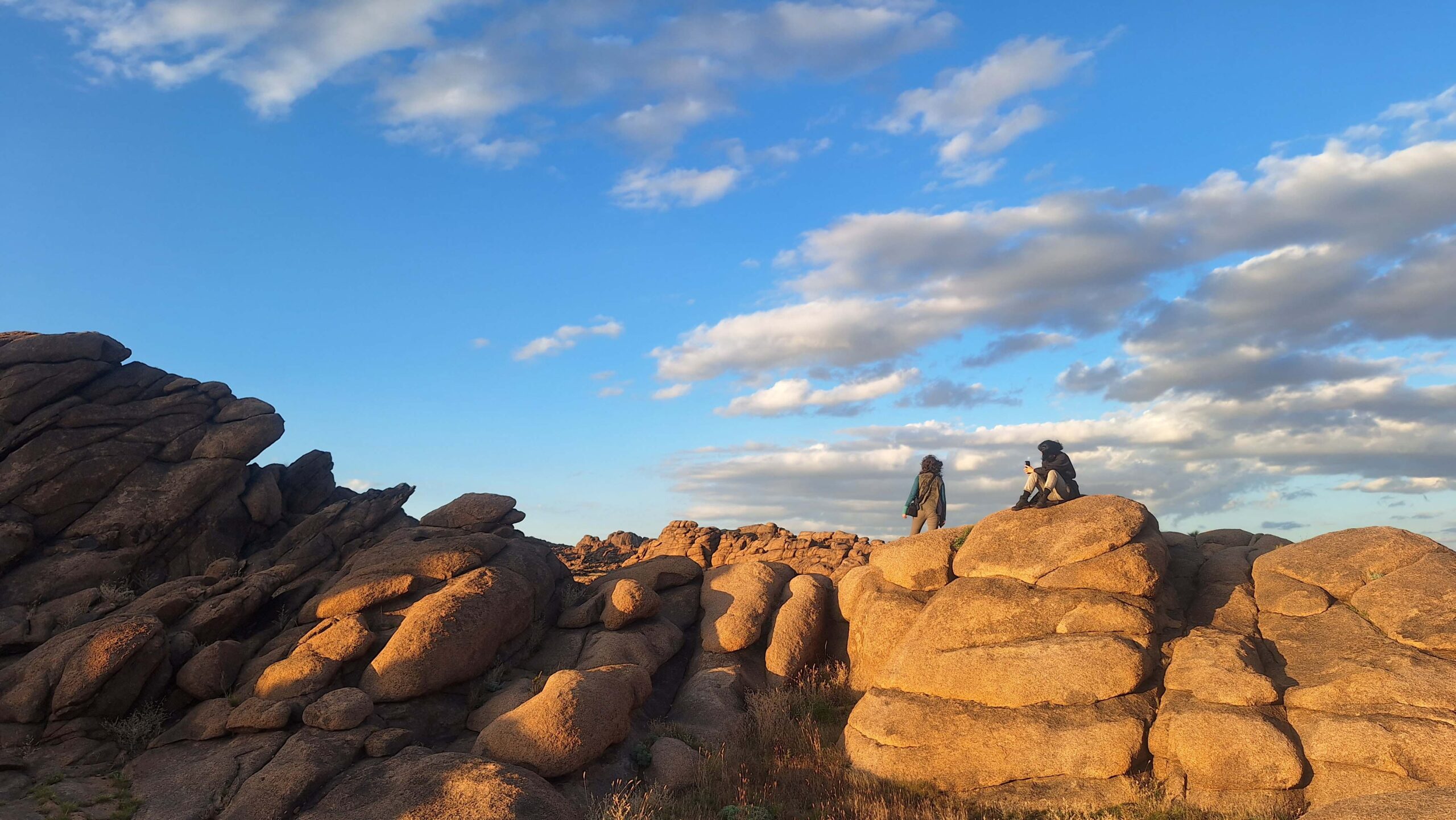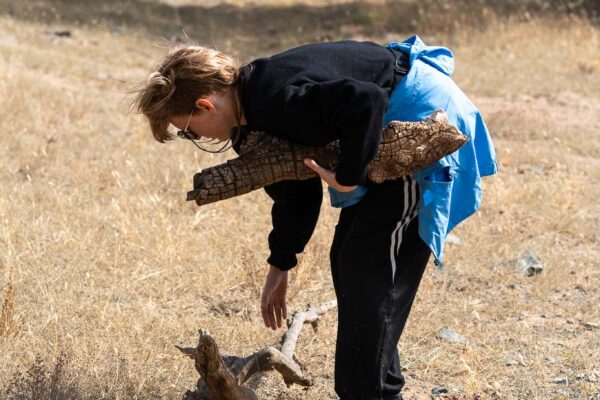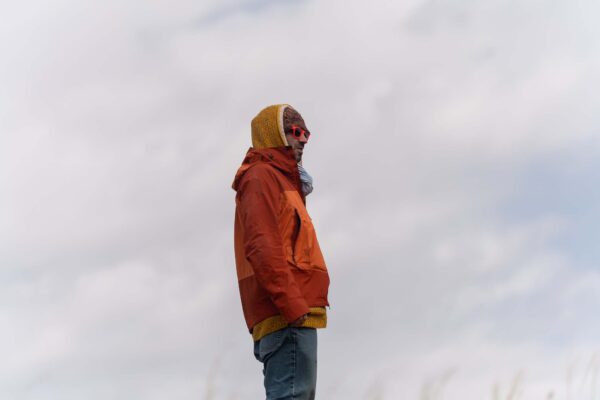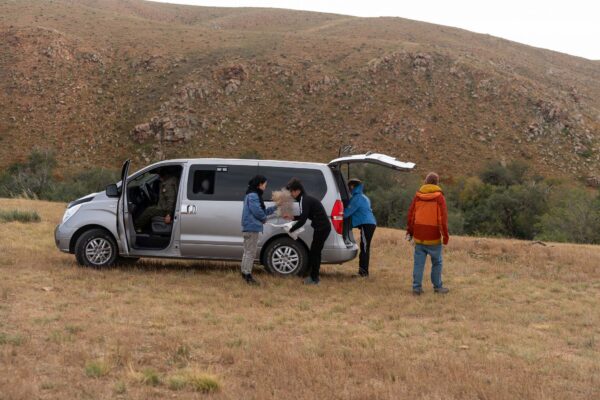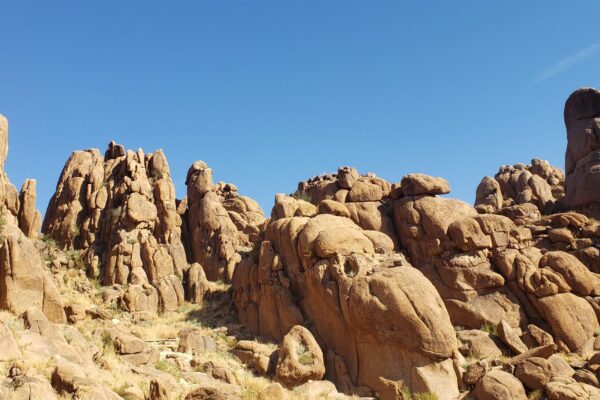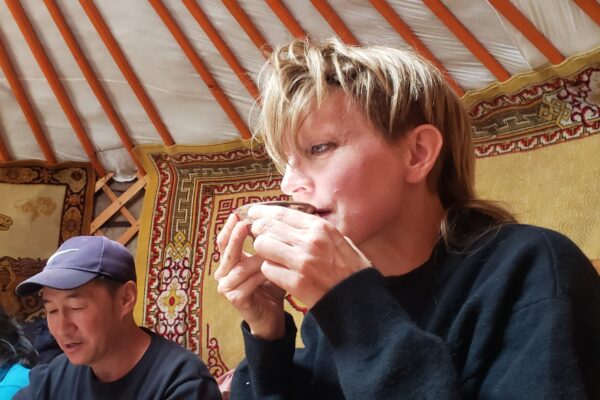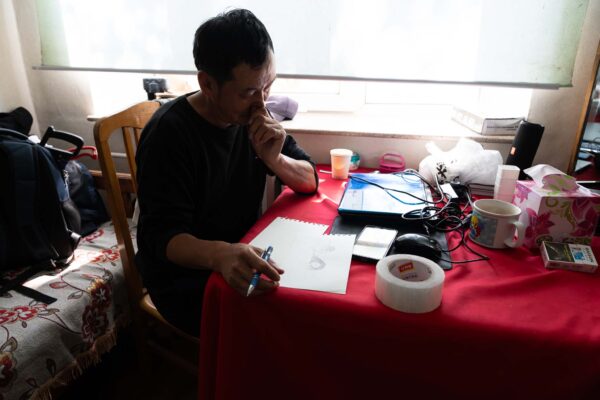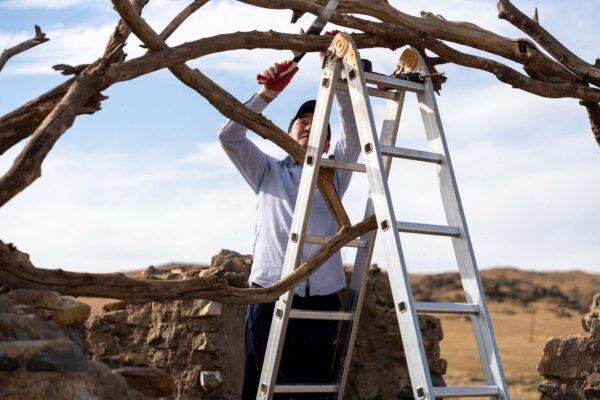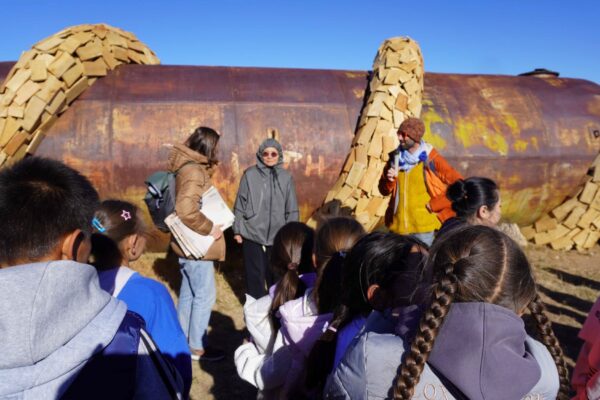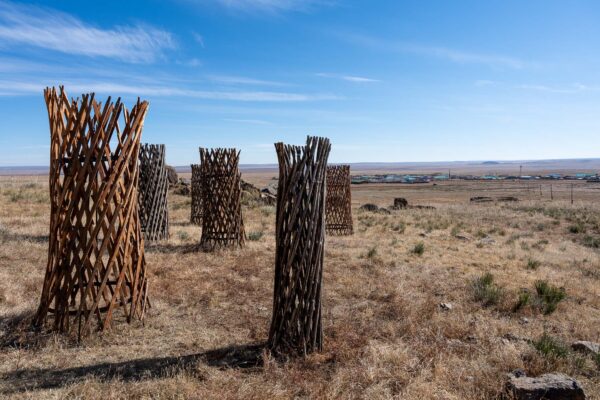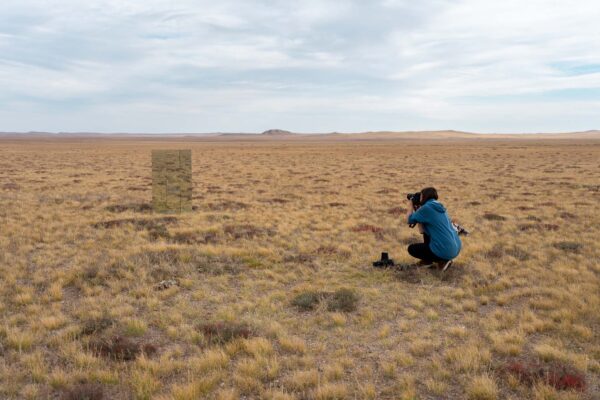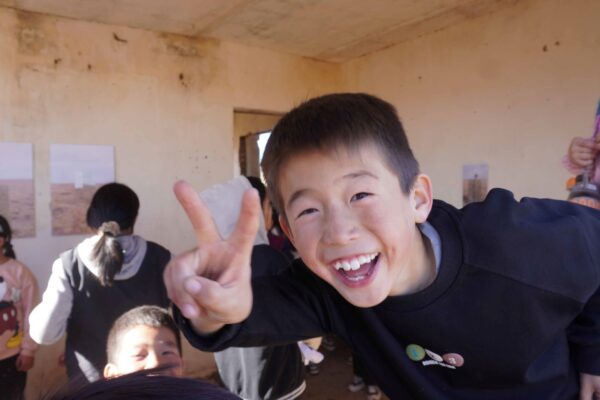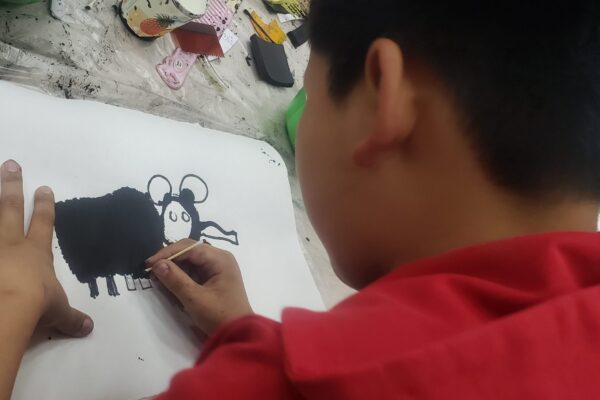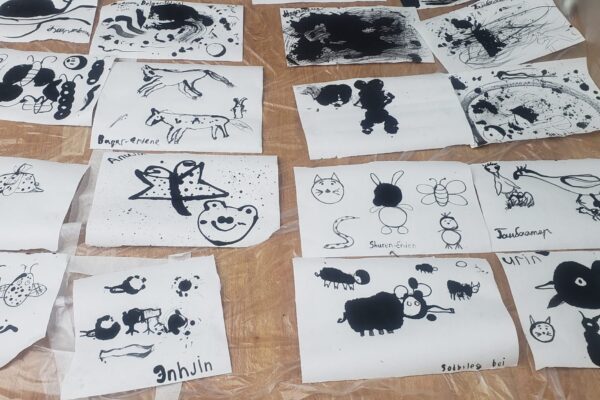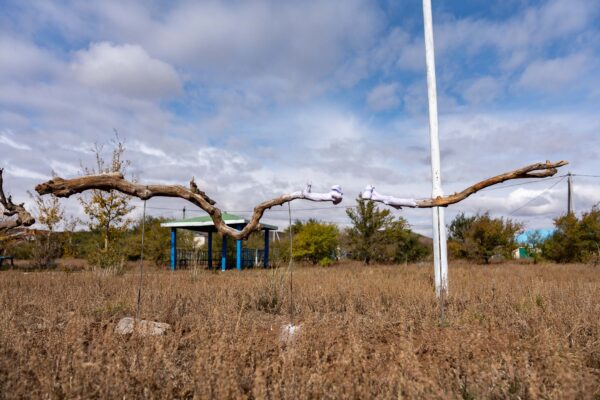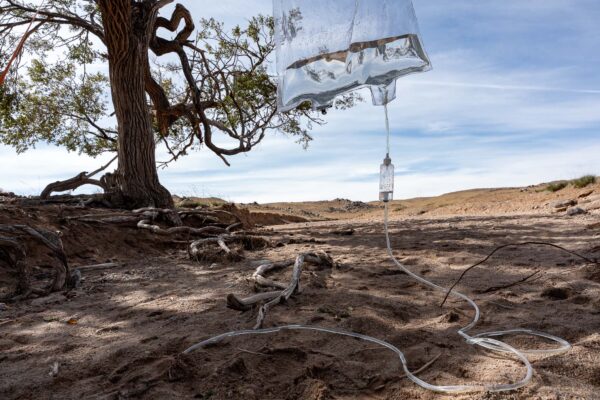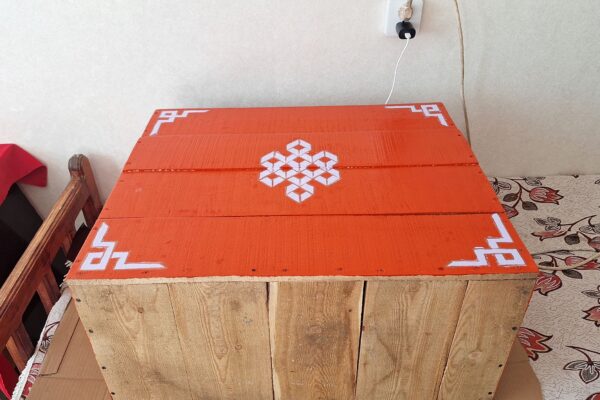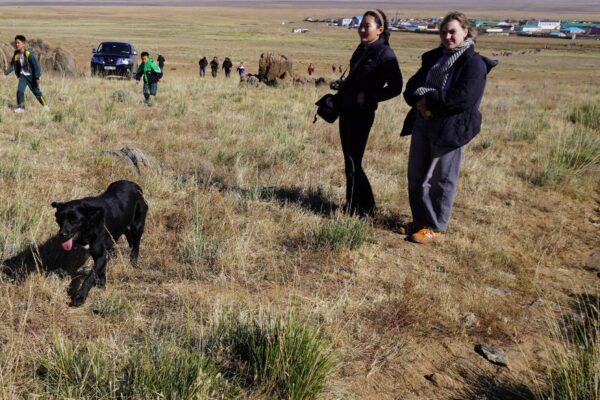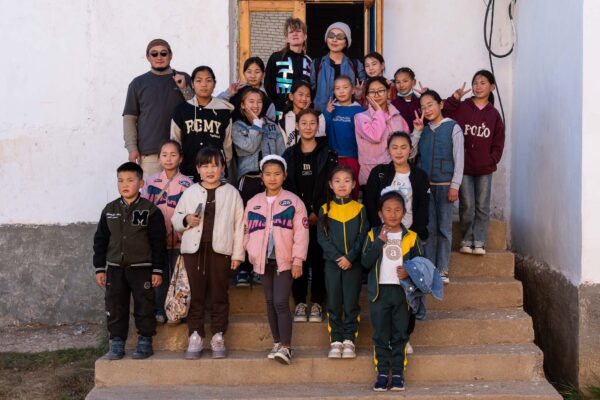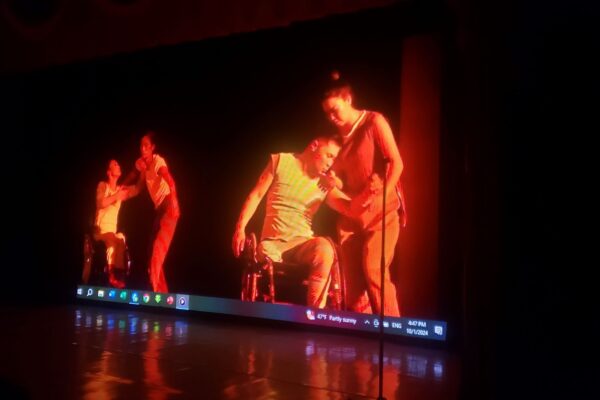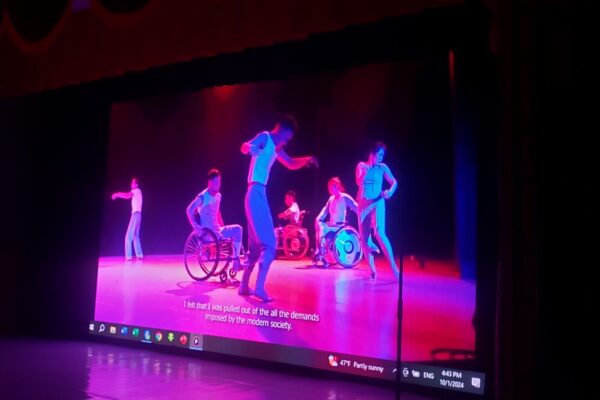The international art program Nomad Spirit took place in Deren Soum of Dundgovi Province from September 21 to October 2, 2024. Initiated by the EUNIC Mongolia, with aim to raise public awareness of climate change through contemporary artistic practices, the program brought together over 260 participants, including 8 artists from 5 different countries, as well as local schoolchildren, residents, administrators, and visitors from Ulaanbaatar.
The artistic team included Amarsaikhan Namsraijav (Mongolia), Cornelia Konrads (Germany), elparo (France), Elena Kristofor (Austria), Laura Merz (Finland), Munkhdorj Batdelger (Mongolia), Tuvshinjargal Lhaasuren (Mongolia), and Zultsetseg Narantsogt (Mongolia). The initiative served as a medium for cultural exchange and collaboration, led by curator Gantuya Badamgarav (Founding director of the Mongolian Contemporary Art Support Association and Red Corner International Residency), Khongorzul Enkhtuvshin as assistant to curator and filmmaker Chinbold Lkhagvasuren documenting the experience.
After immersing themselves in the natural landscape, environment, and the nomadic way of life around the Deren soum and Ikh Gazriin Chuluu, the participating artists had established their base in the heart of Deren Soum, a small administrative center with a population of around 450 people. While staying at Deren Soum, the project team was actively engaged with the organization of workshops, open discussions, and creative activities, focusing on local cultures, environment, ecology, and climate changes, involving over 200 schoolchildren and the local community of Deren Soum. A major topic of discussion was the responses of different countries, individuals, and artists towards pressing environmental issues, and how traditional nomadic lifestyles and philosophies can be adapted to modern life as response to these problems.
Despite the challenges posed by unpredictable weather and the logistical demands of working in such a remote setting, the project’s collaborative spirit turned Deren Soum into a dynamic space for dialogue between art, nature and people, connecting local traditions to a broader conversation about ecological stewardship. The program culminated on October 2 with the Nomad Spirit – Public Art Day, showcasing more than 430 artworks of varying scales created by participating artists and local schoolchildren. These pieces were presented across diverse indoor and outdoor locations, including natural settings, the school building, ruins, and an abandoned house. At the heart of this exhibition was the idea of transforming waste, discarded materials, and forgotten spaces into works of art. By repurposing paper, paint, wood, and upcycled materials, the artists aimed to spark a dialogue about reducing harmful consumption and inspire viewers to reconsider their relationship with the environment.
Funded by EUNIC, the Nomad Spirit – International Program was initiated by EUNIC Mongolia and its implementing members, the Alliance Française Oulan-Bator, the Austrian Embassy in Beijing, the Finnish Embassy in Beijing, and the Goethe-Institut Mongolia with the support of the EU Delegation to Mongolia and implemented by the Mongolian Contemporary Art Support Association and its affiliate Nomadic Red Corner International Residency and Deren Soum administration and secondary school.
*EUNIC — European Union National Institutes for Culture — is Europe’s network of national cultural institutes and organisations, with 39 members from all EU member states and associated countries. EUNIC Mongolia aims to develop strong and sustainable ties between cultural stakeholders in the European Union and Mongolia by engaging in activities that are driven by the global challenges we have to respond to together.
see more about artists, artworks and events >>
see more about artists, artworks and events >>
see more about artists, artworks and events >>
see more about artists, artworks and events >>
Research around Deren Soum of Dundgobi Province
Arriving in Deren Soum marked the beginning of a profound journey for the artists of the Nomad Spirit Project, as they set out to explore the local environment, climate, and community. While they moved through the distinctive landscape, they engaged directly with the land by gathering a variety of natural materials—such as stones, plant fibers, and clay—that illustrated the region’s ecological richness. This active involvement allowed them to understand the habitat, which has experienced significant changes in recent years due to water scarcity and the alarming reduction of nearby lakes. Grounded in this ecological and cultural awareness, the artists were encouraged to investigate themes of resilience, adaptation, and the interplay between human experiences and the natural world in their works.
Photo credit: Chinbold Lkhagvasuren
Travel to Ikh Gazriin Chuluu, Gurvansaikhan Soum of Dundgobi Province
The second and third days of the Nomad Spirit Project were spent in the peaceful and majestic surroundings of Ikh Gazriin Chuluu at Dundgovi province, where ancient rock formations rise quietly from the desert floor. The group explored nearby rock hills and caves during the stay, walking through hidden chambers carved over centuries.
Photo credit: Chinbold Lkhagvasuren
Visit to nomadic family at Ikh Gazriin Chuluu
The experience was further enriched by a visit to a nomadic family during the trip to Ikh Gazriin Chuluu, where the group was welcomed with warm hospitality of the steppe. Invited into the family’s ger, they shared a traditional meal that went beyond sustenance, helping to understand the values and customs that define this lifestyle. Through intimate interactions, the artists found an understanding of the simplicity and resilience of the nomads, as well as their strong connection to the environment.
Photo credit: Gantuya Badamgarav
Site-specific installation by Amarsaikhan Namsraijav
Combining the ruins of a stone house built more than 60 years ago in Deren Soum and the dead branches of elm trees collected from Khailaast Valley, Mongolian artist Amarsaikhan Namsraijav has created his amazing site-specific installation entitled “A Memory of Nature”. Artist Amarsaikhan says, “I created this installation to bring another life to this abandoned ruin and lifeless twigs, to remind people that everything in this universe has its own memory, soul and the beauty.
Recognized for his large-scale installations created using natural elements such as mud, earth, and dead branches of wood, artist Amarsaikhan Namsraijav’s conceptual practice addresses vanishing cultures and wisdom of nomads, who lived in harmony with nature, having minimal consumption and self-sustainable lifestyle. Grew up in a traditional nomadic environment, artist Amarsaikhan initiated the Nomadic Art Project in 2009 and started working mostly in nature, mastering the skills of transforming waste materials into huge installations that amplify nature and resemble a nomadic lifestyle. Amarsaikhan has been participating in various international exhibitions and festivals held in South Korea, India, Japan, China, Mongolia, Italy, France, Hungary, Taiwan, Croatia, and in nearly 20 international residency programs in Finland, France, Italy, Hungary, Korea, Taiwan, India, the USA, Japan, and Mongolia. For his exceptional environmental art projects, artist Amarsaikhan received the Samu Geza Dij Award from the Hungarian Academy of Arts; the Leading Cultural Worker of Mongolia Medal from the Ministry of Culture; the Prize of Union of Mongolian Artists, Mongolia; the Austronesian International Arts Award by Taitung Art Museum, Taiwan; Grant by Kuan Shu Education Foundation for Environmental Art Project, Taiwan; Rubin Fellowships for Himalayan Artists, NY, USA.
Photo credit: Chinbold Lkhagvasuren
El Paro's site-specific installation created on the exterior of old iron tanker
While exploring the area around Deren soum, French artist elparo found old iron tanker used for containing oil. Fascinated with its rustic look, monumental shape, and its relationship with the landscape, artist created site-specific wooden installation on the exterior of the old iron tanker, a reminiscent of a plant growing around it. The work highlights the beauty of this old tanker which could seem lifeless for many.
elparo spent most of his life on the road meeting new cultures, considering himself as a world student, believing that others have much more to teach him. He developed many projects together with local communities and artists, shared common experiences and an adventure. He created installations in very diverse conditions, in the middle of nature, where respect is required, in the middle of the city, where human and architectural interaction is predominant, or in places without resources, such as in Lebanon where the raw material is far too precious to use it other than for building and heating. Challenges and need for adaptation make me feel alive, artist says. elparo’s large-scale site-specific installations have been created in many countries worldwide, including France, Belgium, Germany, Portugal, Japan, Spain, South Africa, Lebanon, Luxembourg, Canada, England, and New Zealand.
Photo credit: Chinbold Lkhagvasuren
Cornelia Konrad’s site-specific installation created among the rocky hills of Deren Soum
German artist Cornelia Konrads has created a site-specific installation using old broken walls of a Mongolian traditional house “ger” and placed it among the rocky hills located in the northwest side of Deren Sum. Deeply intrigued with the traditional nomadic lifestyle, particularly shapes and structures of “ger”, Cornelia developed an interest in using its elements for her installation, already before coming to Mongolia. With the help of local team Cornelia managed collecting old broken walls of traditional “ger” and constructed cone-like shaped structures with the help of Mongolian artist Munkhdorj Batdelger. Cornelia says, “The walls of a ger are strong but also flexible, like Mongolians, so these sculptures are resemblance of Mongolians for me.”
Born 1957 in Wuppertal, Germany, Cornelia studied philosophy and cultural science. She is practicing art since 1998, focusing on site specific sculpture and installation. Cornelia created permanent and temporary works for public spaces, sculpture parks and private collections, participating in sculpture and land art projects in Europe, Asia, Australia, America, and Africa. Since 1998, she has been carrying out various projects abroad, particularly in France, the Netherlands, Belgium, Italy, Sweden, the US, Canada, South Africa, Australia, Austria, France, Germany, India, Norway, Brazil, South Korea, Taïwan and Japan.
Between nature and culture, Cornelia Konrads’ works are always in dialogue with the place that hosts them, its architecture, topography, flora and history. She is inspired by forms present in the landscape, divert them and reveal their poetic, comic or mysterious aspect. Her in situ installations, permanent or ephemeral, aim to create unstable moments, spaces of uncertainty close to catastrophe, that humorously defy the laws of gravity and construction. (Nadege Lecuyer 2023)
Photo credit: Chinbold Lkhagvasuren
Elena Kristofor’s photographic installation in abandoned house
Austrian artist Elena Kristofor’s works consisted of hand-processed pigment prints created using tumbleweed found in Deren Soum and photographs taken in the open, expansive steppe of Deren Soum, where she used three-sided vertical mirror to explore the dynamic tension between verticality and horizontality or could be seen as a submergence of contrasting images of openness and its fractions. Elena displayed her works in an abandoned house, juxtaposed with a site-specific installation, she created with a pile of tumbleweed.
Born and raised in Odesa, Ukraine, Elena Kristofor is a Vienna-based visual artist whose work digs into the dynamic tension between the open, expansive steppe and the vertical confinement of forests. These contrasting landscapes serve as metaphors for the themes she explores—alienation, threat, loss of identity, and the ongoing search for belonging. Her art acts as a reflection of both the physical environments that shaped her and the broader existential questions they evoke. Primarily working in photography and installation, Kristofor combines elements of architecture, drawing, and sculpture to investigate the boundaries between two- and three-dimensional spaces. Her practice is rooted in an intimate conversation with the natural world, where each project responds to her immediate surroundings and the landscapes she navigates. Much like the steppe and the forest—spaces of openness and enclosure—her art occupies the liminal space between nature and culture, permanence and fragility. Elena’s works have been displayed in over 60 exhibitions internationally in Austria, China, Romania, Denmark, UK, Ukraine, Germany and Serbia.
Photo credits: Chinbold Lkhagvasuren, Munkhjargal Jargalsaikhan
Laura & Deren Kids: Workshop Series and Exhibitions
One of the most engaging activities organized during the program was a series of workshops led by Finnish artist Laura Merz. Involving over 200 school children, Laura taught them playful methods of ink painting with experimental tools to create animal images, while exploring their surrounding environment and listening to their feelings. Around 220 works created by children and Laura were in display on the floor of sports complex of the school.
Laura Merz is a visual artist and designer from Finland, specializing in public art, illustration, and children’s cultural projects. Her illustrations have been exhibited internationally, and her public artworks are featured in several prestigious buildings in Finland. She also organizes art workshops for both children and adults and frequently gives talks at various events around the world. Passionate about traditional craft techniques and working with natural materials, Laura uses a variety of media including painting, collage, textiles, and woodwork. Drawing inspiration from the natural world, she often depicts wildlife in an intuitive and expressive style. Laura’s approach is experimental, frequently collaborating with other artists and incorporating interactive, participatory elements into her works. Empathy, optimism, and intuition are core values in her practice, allowing her to share meaningful experiences with others.
Laura Merz has been exhibiting her works in Finland, Slovenia, Sweden, USA, Arab Emirates, UK, South Korea, Italy, France, China, Estonia and Germany, received over 20 international prestigious awards such as ADC*E Art Directors Club Europe Awards gold prize 2023, USBBY Outstanding International Books List (USA) 2021, Seymour Chwast Prize, Museum of Avant-garde Awards (CH) 2021, Japan Illustration Awards bronze prize (JP) 2019, 2018, Ibby Honours List (INTL) 2018.
Photo credits: Chinbold Lkhagvasuren, Muknjargal Jargalsaikhan, Gantuya Badamgarav
Zula & Deren Kids: Workshops Series and Exhibitions
Another most engaging activity organized during the program was a series of workshops led by Mongolian artist Zultsetseg Narantsogt. Involving over 200 school children, artist Zultsetseg taught practical, yet playful ways to create graphic artwork using natural elements such as leaves, grasses and wood and environmentally friendly paints and papers. During workshops, the artists and school children have created over 200 pieces of graphic works, which were printed in small to large size papers by other participating artists, creating new compositions. Works were displayed in the corridor of elementary school.
Born in 1992 in Mongolia, Narantsogt Zultsetseg is a multimedia artist currently living in Ulaanbaatar. She graduated from the School of Fine Arts at the Mongolian State University of Arts and Culture with a focus on monumental painting and continued her studies in graphic arts at the University of Applied Arts in Vienna from 2017 to 2021. Zultsetseg has held solo exhibitions in Mongolia and Austria and has participated in over 30 group exhibitions across Austria, Japan, Korea, Germany, and China. Her artistic practice spans various mediums including drawing, graphics, photo-based encaustic painting, and ceramics. Zultsetseg combines abstract and realistic forms, often using natural elements to reflect on her personal experiences and inner perceptions. Through her work, she invites viewers to explore the deep connection between living organisms and nature, seeking to understand the underlying essence of all existence.
Photo credits: Chinbold Lkhagvasuren, Muknjargal Jargalsaikhan, Gantuya Badamgarav
Tuvshinjargal Lkhaasuren’s sculptures and installations created in the garden of Deren Soum
Mongolian artist Tuvshinjargal Lkhaajav placed his abstract sculptures made of discarded wood and animal bones, reminiscent of lives lost, as well as a large-size drip system for watering trees in the park of Deren Soum, reflecting the need for water in Deren Soum area.
Born in 1987, artist Tuvshinjargal studied ceramics and decorative art at the School of Fine Arts of the University of Arts and Culture of Mongolia under the guidance of well-known Mongolian sculptor Sereeter. His artistic practice includes ceramics, fiber glass and metal sculptures and outdoor installations. At the initial stage of his career, Tuvshinjargal created fiber glass and metal sculptures that are heavily influenced by figurative abstract art. His forms were usually abstractions of animal figures, mostly depicting horses and camels, as well as nomadic household items. Tuvshinjargal has been actively participating in annual exhibitions organized by Union of Mongolian Artists and various sculpture symposiums. He has also completed several commissioned works for the public areas of Ulaanbaatar city.
Photo credit: Chinbold Lkhagvasuren
Multimedia work of Munkhdorj Batdelger installed inside of the school building
Another smaller size but engaging work was created by artist Munkhdorj Batdelger. He crafted a Mongolian traditional chest with an infinite visible space created with the help of a mirror, in which he placed green plants. Through his work, artist Munkhdorj evokes the importance of Mongolian tradition and its relationship with nature. The work is now placed inside the school.
Munkhdorj Batdelger is a multimedia artist specializing in media installations. He holds a master’s degree in Media Production (2020) and a bachelor’s degree in Graphic Design / Media Animation (2017). Since 2018, Munkhdorj has been teaching at the Mongolian State University of Arts and Culture, where he became head of the Media Animation Department in 2022. Munkhdorj’s art focuses on blending media technology with public art, creating immersive, interactive installations that encourage reflection on memory, connection, and the shifting dynamics between people and technology.
Photo credits: Chinbold Lkhagvasuren, Munkhdorj Batdelger
Public Art Day
As a part of the Nomad Spirit – Public Art Day, over 430 small to large scale works of participating artists and school children were presented to the public in indoor and outdoor areas of Deren Soum, including garden, natural places, school building, ruins and abandoned house. Official opening of the event held in an outdoor area featuring the work of German artist Cornelia Konrads.
Around 200 children running towards the opening spot resembled river flow or antelopes in the middle of the field. And the dogs were there too running together with children. At the opening ceremony, the singer Narandulam sang traditional Mongolian long song “Under the Sun of Placid World” in an open area surrounded with the vast plains of Deren Sum, the birthplace of the great singer Norovbanzad. Over 250 people attended the event, including artists, school children and teachers, organizers, Leonhard Heydecker, Director of Goethe Institut in Ulaanbaatar, Amartuvshin Lkhagva, Governor of Deren Soum, representatives of the Alliance Française d’Oulan-Bator and other guests from Ulaanbaatar.
Photo credits: Chinbold Lkhagvasuren, Muknjargal Jargalsaikhan
Film Day
A film day was organized at the Deren Soum Culture Center on 1 Oct 2024, for schoolteachers and children, presenting 3 documentary films; Korean-born Brazilian filmmaker Iara Lee’s work “From Trash to Treasure”, “Nogoonbaatar Eco Art Festival”, EUNIC funded project implemented in Ulaanbaatar in 2021 and “Encounters”, a modern dance piece with the participation of Mongolian wheelchaired dancers. The event was moderated by Gantuya Badamgarav, the founding director of the Mongolian Contemporary Art Support Association and the Red Corner International Residency. After film screenings, an open discussion was organized focusing on films as well as climate change and ecological problems around the world, and how traditional nomadic lifestyles and philosophies can be adapted to modern life as response to these challenges.


